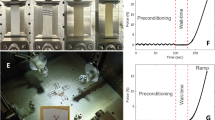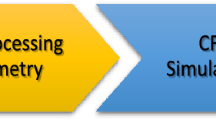Abstract
Purpose
Preclinical testing of neurovascular devices is crucial for successful device design and is commonly performed using in vivo organisms such as the rabbit elastase-induced aneurysm model; however, simple in vitro models may help further refine this testing paradigm. The purpose of the current work was to evaluate, and further develop, tissue-engineered blood vessel mimics (BVMs) as simple, early-stage models to assess neurovascular devices in vitro prior to animal or clinical use.
Methods
The first part of this work used standard straight-vessel BVMs to evaluate flow diverters at 1, 3, and 5 days post-deployment. The second part developed custom aneurysm-shaped scaffolds to create aneurysm BVMs. Aneurysm scaffolds were characterized based on overall dimensions and microstructural features and then used for cell deposition and vessel cultivation.
Results
It was feasible to deploy flow diverters within standard BVMs and cellular linings could withstand and respond to implanted devices, with increasing cell coverage over time. This provided the motivation and foundation for the second phase of work, where methods were successfully developed to create saccular, fusiform, and blister aneurysm scaffolds using a wax molding process. Results demonstrated appropriate fiber morphology within different aneurysm shapes, consistent cell deposition, and successful cultivation of aneurysm BVMs.
Conclusion
It is feasible to use tissue-engineered BVMs for assessing cellular responses to flow diverters, and to create custom aneurysm BVMs. This supports future use of these models for simple, early-stage in vitro testing of flow diverters and other neurovascular devices.





Similar content being viewed by others
References
Wong JH, Tymianski R, Radovanovic I, Tymianski M (2015) Minimally invasive microsurgery for cerebral aneurysms. Stroke 46(9):2699–2706. https://doi.org/10.1161/STROKEAHA.115.008221
Writing Group M, Mozaffarian D, Benjamin EJ, Go AS, Arnett DK, Blaha MJ, Cushman M, Das SR, de Ferranti S, Despres JP, Fullerton HJ, Howard VJ, Huffman MD, Isasi CR, Jimenez MC, Judd SE, Kissela BM, Lichtman JH, Lisabeth LD, Liu S, Mackey RH, Magid DJ, DK MG, Mohler ER 3rd, Moy CS, Muntner P, Mussolino ME, Nasir K, Neumar RW, Nichol G, Palaniappan L, Pandey DK, Reeves MJ, Rodriguez CJ, Rosamond W, Sorlie PD, Stein J, Towfighi A, Turan TN, Virani SS, Woo D, Yeh RW, Turner MB, American Heart Association Statistics C, Stroke Statistics S (2016) Heart disease and stroke statistics-2016 update: a report from the American Heart Association. Circulation 133(4):e38–e360. https://doi.org/10.1161/CIR.0000000000000350
(2012) What you should know about cerebral aneurysms. Accessed May 2017
Maurice-Williams RS, Lafuente J (2003) Intracranial aneurysm surgery and its future. J R Soc Med 96(11):540–543
Altes TA, Cloft HJ, Short JG, DeGast A, Do HM, Helm GA, Kallmes DF (2000) 1999 ARRS Executive Council Award. Creation of saccular aneurysms in the rabbit: a model suitable for testing endovascular devices. American Roentgen Ray Society. AJR Am J Roentgenol 174(2):349–354. https://doi.org/10.2214/ajr.174.2.1740349
Cloft HJ, Altes TA, Marx WF, Raible RJ, Hudson SB, Helm GA, Mandell JW, Jensen ME, Dion JE, Kallmes DF (1999) Endovascular creation of an in vivo bifurcation aneurysm model in rabbits. Radiology 213(1):223–228. https://doi.org/10.1148/radiology.213.1.r99oc15223
de Oliveira IA (2012) Main models of experimental saccular aneurysm in animals. In: Murai Y (ed) Aneurysm. IntechOpen, pp 43–64. https://doi.org/10.5772/50310
Ding YH, Dai D, Lewis DA, Danielson MA, Kadirvel R, Cloft HJ, Kallmes DF (2006) Long-term patency of elastase-induced aneurysm model in rabbits. AJNR Am J Neuroradiol 27(1):139–141
Fujiwara NH, Kallmes DF (2002) Healing response in elastase-induced rabbit aneurysms after embolization with a new platinum coil system. AJNR Am J Neuroradiol 23(7):1137–1144
Kallmes DF, Fujiwara NH, Berr SS, Helm GA, Cloft HJ (2002) Elastase-induced saccular aneurysms in rabbits: a dose-escalation study. AJNR Am J Neuroradiol 23(2):295–298
Kallmes DF, Ding YH, Dai D, Kadirvel R, Lewis DA, Cloft HJ (2009) A second-generation, endoluminal, flow-disrupting device for treatment of saccular aneurysms. AJNR Am J Neuroradiol 30(6):1153–1158. https://doi.org/10.3174/ajnr.A1530
Kim BM, Kim DJ, Kim DI (2016) A new flow-diverter (the FloWise): in-vivo evaluation in an elastase-induced rabbit aneurysm model. Korean J Radiol 17(1):151–158. https://doi.org/10.3348/kjr.2016.17.1.151
Sadasivan C, Cesar L, Seong J, Wakhloo AK, Lieber BB (2009) Treatment of rabbit elastase-induced aneurysm models by flow diverters: development of quantifiable indexes of device performance using digital subtraction angiography. IEEE Trans Med Imaging 28(7):1117–1125. https://doi.org/10.1109/TMI.2008.2012162
Gailloud P, Pray JR, Muster M, Piotin M, Fasel JH, Rufenacht DA (1997) An in vitro anatomic model of the human cerebral arteries with saccular arterial aneurysms. Surg Radiol Anat 19(2):119–121
Sugiu K, Tokunaga K, Sasahara W, Watanabe K, Nishida A, Katsumata A, Kusaka N, Date I, Ohmoto T, Rufenacht DA (2004) Training in neurovascular intervention usefulness of in-vitro model and clinical practice. Interv Neuroradiol 10(Suppl 1):107–112. https://doi.org/10.1177/15910199040100S118
Nowicki KW, Hosaka K, He Y, McFetridge PS, Scott EW, Hoh BL (2014) Novel high-throughput in vitro model for identifying hemodynamic-induced inflammatory mediators of cerebral aneurysm formation. Hypertension 64(6):1306–1313. https://doi.org/10.1161/HYPERTENSIONAHA.114.03775
Uzarski JS, Scott EW, McFetridge PS (2013) Adaptation of endothelial cells to physiologically-modeled, variable shear stress. PLoS One 8(2):e57004. https://doi.org/10.1371/journal.pone.0057004
Mannino RG, Myers DR, Ahn B, Wang Y, Margo R, Gole H, Lin AS, Guldberg RE, Giddens DP, Timmins LH, Lam WA (2015) Do-it-yourself in vitro vasculature that recapitulates in vivo geometries for investigating endothelial-blood cell interactions. Sci Rep 5:12401. https://doi.org/10.1038/srep12401
Touroo JS, Williams SK (2012) A tissue-engineered aneurysm model for evaluation of endovascular devices. J Biomed Mater Res A 100(12):3189–3196. https://doi.org/10.1002/jbm.a.34256
Bonnema GT, Cardinal KO, Williams SK, Barton JK (2009) A concentric three element radial scanning optical coherence tomography endoscope. J Biophotonics 2(6–7):353–356. https://doi.org/10.1002/jbio.200910024
Cardinal KO, Bonnema GT, Hofer H, Barton JK, Williams SK (2006) Tissue-engineered vascular grafts as in vitro blood vessel mimics for the evaluation of endothelialization of intravascular devices. Tissue Eng 12(12):3431–3438. https://doi.org/10.1089/ten.2006.12.3431
Gibbons MC, Foley MA, Cardinal KO (2013) Thinking inside the box: keeping tissue-engineered constructs in vitro for use as preclinical models. Tissue Eng Part B Rev 19(1):14–30. https://doi.org/10.1089/ten.TEB.2012.0305
Herting S, diBartolomeo A, Pipes T, Kunz S, Temnyk K, T J, Ur S, Cardinal KO (2016) Human umbilical versus coronary cell sources for tissue-engineered blood vessel mimics. Appl In Vitro Toxicol 2(3):175–182
Punchard MA, O’Cearbhaill ED, Mackle JN, McHugh PE, Smith TJ, Stenson-Cox C, Barron V (2009) Evaluation of human endothelial cells post stent deployment in a cardiovascular simulator in vitro. Ann Biomed Eng 37(7):1322–1330. https://doi.org/10.1007/s10439-009-9701-6
Touroo JS, Dale JR, Williams SK (2013) Bioengineering human blood vessel mimics for medical device testing using serum-free conditions and scaffold variations. Tissue Eng Part C Methods 19(4):307–315. https://doi.org/10.1089/ten.TEC.2012.0311
Beck J, Rohde S, el Beltagy M, Zimmermann M, Berkefeld J, Seifert V, Raabe A (2003) Difference in configuration of ruptured and unruptured intracranial aneurysms determined by biplanar digital subtraction angiography. Acta Neurochir 145(10):861–865; discussion 865. https://doi.org/10.1007/s00701-003-0124-0
Forget TR Jr, Benitez R, Veznedaroglu E, Sharan A, Mitchell W, Silva M, Rosenwasser RH (2001) A review of size and location of ruptured intracranial aneurysms. Neurosurgery 49(6):1322–1325 discussion 1325–1326
Raghavan ML, Ma B, Harbaugh RE (2005) Quantified aneurysm shape and rupture risk. J Neurosurg 102(2):355–362. https://doi.org/10.3171/jns.2005.102.2.0355
Seibert B, Tummala RP, Chow R, Faridar A, Mousavi SA, Divani AA (2011) Intracranial aneurysms: review of current treatment options and outcomes. Front Neurol 2:45. https://doi.org/10.3389/fneur.2011.00045
Weir B, Disney L, Karrison T (2002) Sizes of ruptured and unruptured aneurysms in relation to their sites and the ages of patients. J Neurosurg 96(1):64–70. https://doi.org/10.3171/jns.2002.96.1.0064
Zheng Y, Xu F, Ren J, Xu Q, Liu Y, Tian Y, Leng B (2016) Assessment of intracranial aneurysm rupture based on morphology parameters and anatomical locations. J Neurointerv Surg 8:1240–1246. https://doi.org/10.1136/neurintsurg-2015-012112
Pipes T (2014) Characterizing the reproducibility of the properties of electrospun poly (D, L-lactide-co-glycolide) scaffolds for tissue-engineered blood vessel mimics. Cal Poly
Acknowledgements
We would like to acknowledge Medtronic Neurovascular and Marc Dawson for providing the flow diverters.
Funding
No funding was received for this study.
Author information
Authors and Affiliations
Corresponding author
Ethics declarations
Conflict of interest
The authors declare that they have no conflict of interest. KOC has received funding from Medtronic Neurovascular and Stryker Neurovascular.
Ethical approval
This article does not contain any studies with human participants or animals performed by any of the authors.
Informed consent
Informed consent was obtained from all individual participants included in this study.
Additional information
Publisher’s note
Springer Nature remains neutral with regard to jurisdictional claims in published maps and institutional affiliations.
Rights and permissions
About this article
Cite this article
Shen, T.W., Puccini, B., Temnyk, K. et al. Tissue-engineered aneurysm models for in vitro assessment of neurovascular devices. Neuroradiology 61, 723–732 (2019). https://doi.org/10.1007/s00234-019-02197-x
Received:
Accepted:
Published:
Issue Date:
DOI: https://doi.org/10.1007/s00234-019-02197-x




